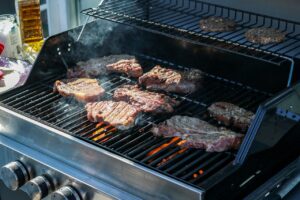Key Takeaway
Before we dive into the details, here’s a quick overview of what you’ll learn in this article:
- Understand the importance of knowing heat zones on your Blackstone griddle.
- Discover the low, medium, and high heat zones and how to use them effectively.
- Learn how to measure and maintain the perfect cooking temperature.
- Get insights into the factors that influence temperature and how to clean and maintain your griddle for optimal performance.
Are you ready to take your grilling skills to the next level? Let’s get started!
Imagine sizzling steaks, perfectly seared burgers, and mouthwatering pancakes. Achieving these culinary masterpieces on your Blackstone griddle requires more than just a good recipe; it’s all about understanding the heat zones. Knowing how to utilize the different temperature zones on your griddle will give you unrivaled control over your cooking and elevate you to grilling greatness.
Understanding Temperature Zones on Blackstone Griddle
To unleash the full potential of your Blackstone griddle, it’s crucial to grasp the concept of temperature zones. Your griddle has three primary heat zones: low, medium, and high. Each zone serves a unique purpose in bringing out the best in your food.
Here’s a breakdown of the temperature zones and their uses:
| Heat Zone | Temperature Range | Suggested Use |
|---|---|---|
| Low Heat Zone | 300°F – 350°F | Warming, melting cheese, toasting buns, delicate foods |
| Medium Heat Zone | 350°F – 450°F | Cooking vegetables, eggs, seafood, and small meat cuts |
| High Heat Zone | 450°F and above | Searing steaks, grilling large meat cuts, stir-frying |
Measuring Temperature on The Blackstone Griddle
Accurate temperature measurement is the key to perfectly cooked meals. Investing in a reliable digital thermometer can make a world of difference. Place the thermometer on the griddle surface to get an accurate reading and ensure your food reaches the desired temperature.
Perfect Temperature for Cooking on Blackstone Griddle
Now that you understand the temperature zones, let’s explore the ideal temperature range for cooking popular food items on your Blackstone griddle.
| Food Item | Ideal Temperature Range |
|---|---|
| Pancakes and Crepes | 325°F – 375°F |
| Burgers and Steaks | 375°F – 450°F |
| Salmon and Fish | 350°F – 375°F |
| Grilled Vegetables | 350°F – 400°F |
| Stir-Fry | 425°F – 475°F |
| Grilled Sandwiches | 375°F – 400°F |
These are general guidelines, but don’t be afraid to experiment and find your preferred temperature for different dishes.
Factors Influencing Temperature
Several factors can affect the temperature on your Blackstone griddle, making it necessary to adapt to varying conditions. Here are a few elements to consider:
- Weather and Wind Conditions: Wind can impact heat distribution, so position your griddle accordingly. Adjust the heat zones accordingly to compensate for external weather factors.
- Seasoning of the Griddle: Proper seasoning of your griddle enhances its heat retention and prevents food from sticking.
- Food Characteristics: Different ingredients can affect temperature, as some food items release moisture that cools the griddle while others absorb heat quickly.
Maintenance and Cleaning
To ensure consistent performance from your Blackstone griddle, regular maintenance and proper cleaning are essential. Follow these tips:
- Clean the griddle surface after each use to prevent grease buildup.
- Use a metal scraper to remove stubborn residue.
- Maintain the temperature control valve by checking for any blockages or malfunctions.
Conclusion
Congratulations! You now possess the knowledge to become a Blackstone Griddle expert. Understanding the heat zones and mastering temperature control will transform your outdoor cooking experience. Remember, experimentation is part of the journey, so don’t hesitate to try new recipes and techniques. With your newfound expertise, impress your family and friends with mouthwatering dishes from the Blackstone griddle.
Now, go heat up your griddle and embark on your culinary adventure!
Disclaimer: The temperature ranges mentioned in this article are general guidelines and may vary depending on your specific griddle and cooking conditions.
